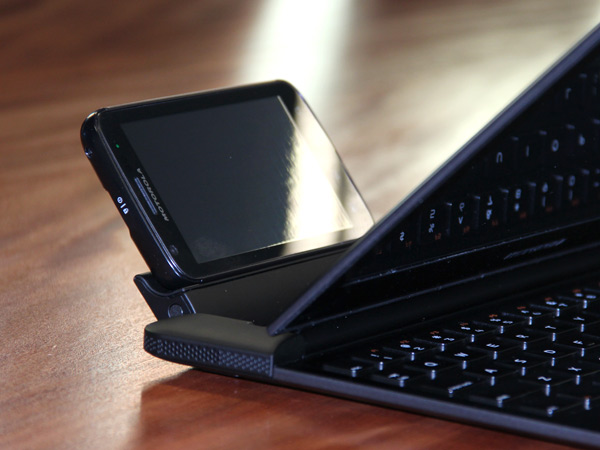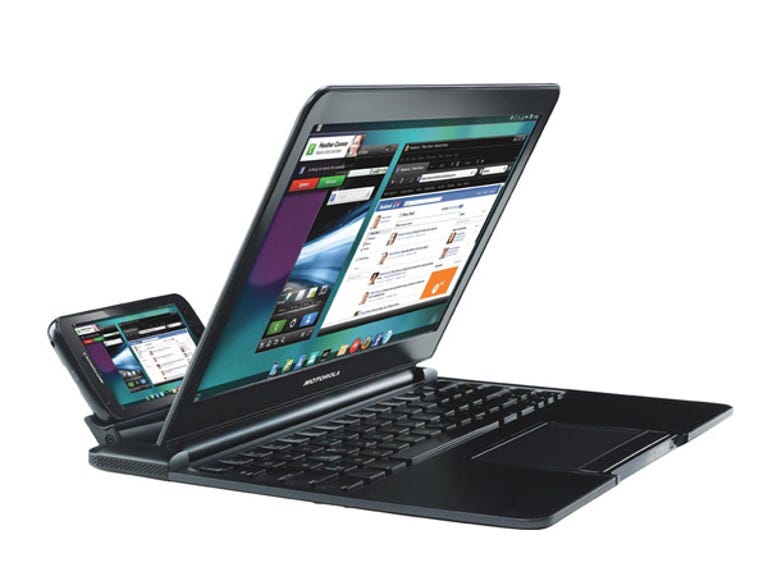 Why You Can Trust CNET
Why You Can Trust CNET Motorola Laptop Dock review: Motorola Laptop Dock
We praise the innovation behind this concept, but we can't recommend the product itself. Though it costs the same as a netbook, the Moto LapDock doesn't deliver even a fraction of the functionality.
At CES earlier this year, Motorola unveiled its concept for the future of smartphones: a handheld that is the centre of your digital life. When you get up in the morning, you pull your phone out of your bedside dock where it serves as an alarm clock. When you get to the office, you plug your phone into a dock and it becomes your computer; then, at the end of the day, your phone slips into something more comfortable: an HD multimedia dock, with your phone becoming the centre of your leisure time, as well. This concept had us gushing after the press conference, imagining this theory in practice.
The Good
The Bad
The Bottom Line

The Motorola Atrix docked in the Laptop Dock.
(Credit: CBSi)
Nearly six months on, and the future is in our hands. Motorola's LapDock accessory for the Atrix smartphone would be a very sexy-looking laptop — if it were a laptop. Instead, it is the shell of a computer waiting to be connected to the processing power and internet connectivity of the Atrix smartphone. It's a screen and a keyboard powered by a 3250mAh battery, with ports for connecting two USB devices and, of course, the Atrix. The smartphone attaches with both micro-USB and mini-HDMI connections simultaneously, preparing it for data transfers, media playback and battery charging all at once.
The Webtop homescreen with the phone's homescreen open in a window on the left.
(Credit: CBSi)
Motorola takes the guesswork out of the setup; the LapDock is simply plug 'n' play. A few moments after your phone is connected, you'll see an application on the LapDock screen that Motorola calls Webtop. By default, this app displays the homescreen of your Atrix in a window, a taskbar along the bottom with the Webtop applications pinned to it and system notifications across.
The screen is a decent 11.6-inches diagonally, though its 1366x768-pixel resolution is a tad low for its size. The full-size keyboard is a pleasure to use, with a chiclet key layout on par with the best laptop keyboards of this size. It also has a touch-sensitive trackpad, which is large and easy to use, and you can switch it on and off by double-tapping on its top-left corner, though, disappointingly, this pad isn't multi-touch as many notebook pads are these days. The LapDock has tinny-sounding external speakers, but if you want to connect your own sound system you can do this through the 3.5mm headphone socket on the phone itself.
The chiclet-style keyboard is well laid out.
(Credit: CBSi)
So, is this the future?
We hope not.
There just isn't that much that you can do with the LapDock accessory. There's a full desktop version of the FireFox Web browser, which is handy, but the processing power of the Atrix struggles to use this browser as efficiently as its own Android browser. You can manage files on your phone, you can watch videos through the Multimedia Centre, you can call and send text messages to contacts or you can use the Android apps installed on your phone. When you list its functionality like this, the lack of a unique application for the LapDock becomes glaringly obvious. It really is an expensive way to add a keyboard and a screen to your phone, however convenient this solution may seem.
Webtop's taskbar: phone functions on the left, apps on the right.
(Credit: CBSi)
It also takes a while to boot up; we've seen the process take 45 seconds before the system was usable, and when you consider that most Windows 7 notebooks will boot up in 30 to 60 seconds, it's hard to see what advantage this system offers.
With the FireFox browser, you get access to a library of installable Add-Ons, which, for all intents and purposes, works like installing new apps. Depending on your requirements, these Add-Ons may get you closer to a usable laptop solution, but in our experience it isn't enough. FireFox Add-Ons are no replacement for a native email client with a layout optimised for the larger display, and for most tasks you'll be relying on Android apps that look dreadful stretched across this screen.
The salt in the wound is the LapDock's AU$449 price tag. This price is only marginally cheaper than the cost of a 15-inch Dell laptop at the time of writing — a Windows system that comes with a 2.8GHz Celeron processor, 4GB RAM and a 500GB hard drive. Or, you could save a hundred bucks and buy a netbook. Owners of a Motorola Atrix will pay a premium for the LapDock accessory and simply not see a return. We love the innovation behind this system; we agree that this could be a glimpse of the future, but those looking for a portable computer are still better off buying a touchscreen tablet or a full-blown laptop.


